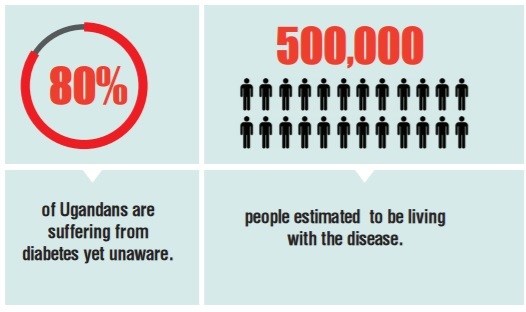
Kampala, Uganda | THE INDEPENDENT | Health workers have been asked to be keen in checking blood glucose for every child who reports to the hospital with any health complaint.
According to Diabetologist Dr William Lumu, this will help them diagnose those who present with diabetes early enough and put them on treatment.
Lumu who is also the President of the Diabetes Association of Uganda says they are seeing an increase in the number of children presenting with both Type 1 and Type 2 diabetes and yet when they turn up to hospital they are wrongly treated for malaria and diarrheal diseases.
Lumu also said that for some children who fail to respond to treatment, parents often resort to using witchcraft.
While ideally, children should not be suffering from Type 2 diabetes, the doctor says many are turning up with the disease partly because they are not being fed well and yet some pregnant mothers are not attending antenatal care the way they should.
Lumu was speaking to journalists just after an awareness creation meeting organized by the Uganda Non – Non-Communicable Diseases Alliance (UNCDA) where it was revealed that the number of people living with diabetes and are aware is equal to the number of those with the disease but are still undiagnosed.
According to the results of the 2023 STEPS Uganda country survey, the total number of people living with Type 2 diabetes has doubled with the prevalence of the disease estimated at 3.3%, up from 1.4% in 2014 when the previous survey was done.
Lumu says these figures which translate to about 1.7 million Ugandans paint just part of the picture as it only represents those that have been diagnosed.
Christopher Kwizera, the UNCDA Executive Director says these figures are worrying that if nothing is done about it, people with diabetes and other non-communicable diseases may increase higher than the health system can handle.
He notes the need to redesign the health system saying it was initially designed to cater for infectious disease and little attention is put into prevention initiatives. According to him, simple messaging on healthy feeding and exercising can help keep many people away from falling sick with diabetes.
As a way of prevention for especially children, Lumu discourages the use of breast milk alternatives such as formula and urges parents to properly feed with vegetables and fruits for older children in addition to encouraging them to do adequate physical exercise.
Meanwhile, generally, among the different types of diabetes, Type 1 is the most common in childhood and adolescence. Figures by the World Health Organisation show about 1.5 million people below 20 years were affected by diabetes in 2019. There were also 16,300 deaths due to diabetes among young people aged 20 and below, 73.7% were due to Type 1.
Experts say managing diabetes among children is quite challenging as they require constant monitoring to watch what they eat and how they exercise else they deteriorate to organ damage affecting their kidneys, the heart, nerves and the eyes.
****
URN
 The Independent Uganda: You get the Truth we Pay the Price
The Independent Uganda: You get the Truth we Pay the Price



